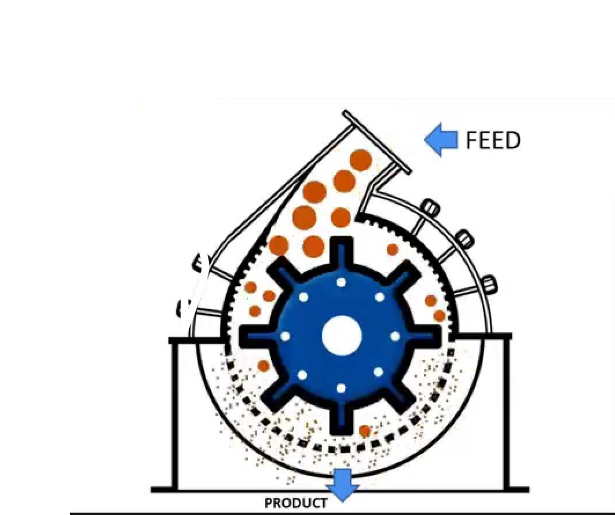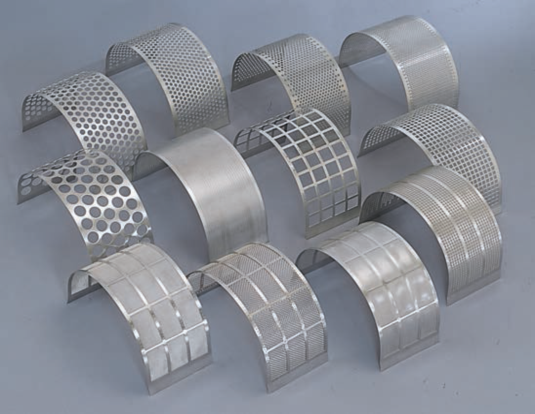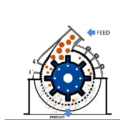
What is a Hammer Mill?
A Hammer mill or Hammermill is a mill that consists of a series of hammers hinged on a central shaft and enclosed within a rigid metal case whose purpose is to shred or crush aggregate material into smaller pieces by the repeated blows of little hammers. These machines have many sorts of applications in many industries. It is one of the most widely used grinding mills and among the oldest.
What is a hammer mill used for?
Hammer mills are used in several industries especially in the pharmaceuticals. The uses of hammer mills include:
-Hammer Mills are used in Ethanol plants to reduce grains to smaller particles
-It is used in pharmaceutical industries to process wet or dry granulations and disperse powder mixtures.
-It is used in milling pharmaceutical raw materials, herbal medicine, and sugar.
-In livestock feed production the machine mills grain into coarse flour to be fed to livestock.
-It is used in the powdering of barks, leaves, and roots of medicinal plants.
–Fluff pulp is a type of chemical pulp made from long fiber softwoods. Hammer mills are used to Fluff pulp defiberizing.
-It is applied in the milling of Active Pharmaceutical Ingredient (API), excipients
-In food processing; Hammer mills are very important in fruit juice production
-Desktop hammer mills is also used for preparing growth media in a life sciences laboratory

How does a Hammer Mill work?
The basic working principle of a hammer mill is straightforward. A hammermill is essentially a steel drum containing a vertical or horizontal rotating shaft or drum on which hammers are mounted. The materials to be milled are struck by these rectangular pieces of hardened steel (ganged hammer) which rotates at high speed inside the chamber. The hammers are free to swing on the ends of the cross, or fixed to the central rotor. The rotor is spun at a high speed inside the drum while the material is fed into a feed hopper. The material is impacted by the hammer bars and is thereby shredded and expelled through screens in the drum of a selected size. There are three factors that basically determine the particle size of a hammer mill. These include:
-Shaft speed (it depends on motor speed and coupling mechanism)
-Hammer or cutting knife configuration
-Screen size
In many instances, the mechanical process of reducing particles that are large in size into smaller units may result in a fine or coarse finish. In order to get a fine finish particle size, you should consider the following key aspects:
-A fast rotating rotor speed
-Small screen size
-Large or/and more crushing knives/hammers
In order to get a coarse finished particle size, it is important to consider the following key aspects:
– A slow rotor speed
-incorporate few and small crushing hammers/knives
– A large screen size
What are the Advantages of a Hammer Mill?
-It produces specific sizes of particles without the need for a closed-circuit crushing system
– Due to self-classification it produces relatively numerous size distributions with a minimum of fines
-It has a high capacity whether used for primary, secondary, or tertiary grinding and a high reduction ratio.
-Relatively easy to install and operate reasonable energy requirements, it occupies small space, it is easy to maintain and clean, and comparatively inexpensive
-Brittle materials are best fractured by impact from blunt hammers.
-Its ease of manufacture allows easier local production and construction.
What are the Disadvantages of a Hammer Mill?
-Hammer mills are not recommended for the fine grinding of very hard and abrasive material due to excessive wear.
-Due to inadequate garbling processes, foreign materials like stone or metals find their way into the material.
– Due to the design of the mill, the possibility of clogging of the screen is very frequent.
– Due to heat generation in the mill head as a result of mill fouling, they are not suitable for low-melting sticky or plastic-like material.
-The mill may be choked if the feed rate is not controlled, leading to damage
Safety Precaution When Operating Hammer Mill
- Hammermill must not be operated solo. At least two workers must be present when the mill is in use. If the machine does not seem to be operating in its usual way, turn it off and report the problem.
- Keep fingers and arms well away from the hopper, carefully feed full-size bundles of material into the hopper. All material must be dry – moist material will clog the screen.
- Always keep fingers and arms well away from the hopper and Feed only at a rate that the mill can process material.
- Always monitor the contents of the catch bag that the material is blown into. When it appears that the bag will be full with the material presently in the mill, stop feeding material and resume only when you remove the full bag and tie on a new bag.
- Operators must always wear eye and hearing protection as well as nuisance dust masks when operating the mill.




